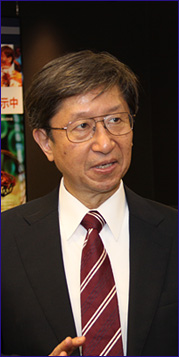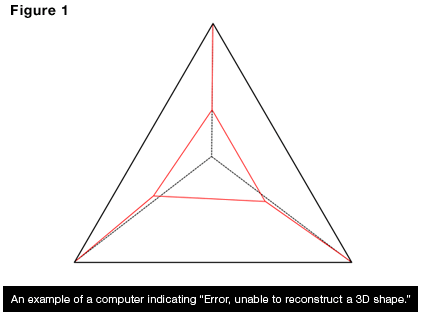

Two-dimensional diagrams beyond a computer’s perception
I specialize in mathematical engineering and engineering geometry, specifically focusing on “the application of geometry to the engineering sciences.” From the start of my career, I have been interested in developing a program with which a computer can perceive 2D drawings. My desire was to allow a computer, by processing information input, to understand a 3D shape based on a projection drawn with lines. This field is now called computer vision or pattern recognition.A computer often fails to reconstruct a 3D shape from a projection drawing and delivers error messages, while humans can do this task very easily. For example, people can recognize a projection of figure 1 as a truncated triangular pyramid. On the other hand, a computer would indicate “Error” because the hand-made drawing is a bit incomplete in that all of the dashed lines do not meet precisely at a point as they are supposed to. This example indicates why this field is so difficult.

In this projection, the hand-made red lines which are supposed to correspond to edges of a truncated triangular pyramid and meet precisely at endpoints are subtly off the dash lines. A computer finds out that data is incomplete and determines that it is “Unable to reconstruct a shape” although we humans easily interpret this projection as an object of a truncated triangular pyramid.
Creation of impossible solids and impossible motion
A trompe l’oeil, referring to an art genre, is painted by using optical illusions.One day, I tried to confirm if my software determines that it is impossible to construct solids from stereoscopic objects depicted in a trompe l’oeil. Unexpectedly, the software reconstructed solids that we never could imagine are possible through human eyes. This interesting result inspired me to create “impossible solids” (pdf). We visualize a 3D object from a 2D drawing based on the preconceived assumption that is obtained through common sense and visual experience. The stereoscopic objects in the trompe l’oeil are painted by exploiting these preconceived assumptions and appear unlikely to our eyes to exist. However, the computer is not influenced by any assumption. The computer examines every possibility in order to reconstruct a 3D object and concludes that it is “Able to do it.” I applied this theory also to create impossible motion.
New field of “computational illusion”
“Computational illusion” is aimed at studying human visual illusions mathematically. If we could reveal how and under what conditions human visual illusions occur, we would be able to numerically express the strength of visual illusions and control the quantity.The numerical system of the human illusion, studied further and consequently applied to practical situations, might be helpful in reducing traffic congestion on freeways. It has been made clear that road design is strongly associated with the occurrence of visual illusions. Traffic congestion recurring in places where there is no specific reason for congestion—no incidence of road accidents or no merging roads—is actually caused by the visual illusions of drivers. While driving, drivers are sometimes confused about whether they are going uphill or downhill. Drivers who are expected to accelerate going uphill misunderstand the terrain that they are on due to the visual illusion, and slow down instead. As a result, traffic congestion occurs.
Conversely, we might produce conspicuous road signs, alarming drivers by applying the mechanism of visual illusion. It is possible that we will do public relations more efficiently or create more effective commercial messages by applying visual illusion. In virtual reality, by inducing visual illusions, we can experience realistic sensations of what is imaginary. As mentioned above, the effects of visual illusions have a strong affinity with the entertainment world, and therefore, I believe that computational illusions have great potential as tools in the entertainment business.
Engineering geometry is applicable to everything that has form
Differences emerge between human perception and mathematical analysis. Engineering geometry involves probing these differences closely in order to find out how humans analyze a phenomenon and employ solutions for the welfare of society. The field is probably useful for any type of industry.For example, engineering geometry could provide information regarding which location for a new hospital is most convenient for members of a community. A formula used in a computer simulates physics experiments for production of spatial discretization in geometry. Moreover, geometry optimizes logistics management in the network. There are many ways in which the study of geometry in relation to anything that has form can contribute to our society. I regard geometry as a truly flexible set of measures and continue to encourage students to maximize their ability to use it to do great work in various fields.
Profile
Dr. Kokichi Sugihara is a specially appointed professor at Meiji University in Tokyo, Japan. He previously taught mathematical engineering as a full professor at the graduate school of the University of Tokyo for nearly two decades from 1991 to 2009. Also, he was a visiting associate professor at Purdue University in West Lafayette, Indiana from 1990 to 1991. His research includes work with Voronoi diagrams and their applications, robust implementation of geometric algorithms, mathematics in visual perception, computer vision and computer graphics, and mesh generation for the finite element method. He has written many books, including textbooks and collections of essays on mathematics. Dr. Sugihara, while researching mathematical applications of engineering science, has been introducing impossible solids and motions (as shown on YouTube) and production based on tricking human optical perception. He is currently a member of many societies including the Japan Society for Industrial and Applied Mathematics and the Information Processing Society of Japan.Relevant Publications
- Sugihara, K. (1986). Interpretation of Line Drawing. MIT Press, Cambridge.- Okabe, A, Boots, B and Sugihara, K (1992). Spatial Tessellations: Concepts and Applications of Voronoi Diagrams. John Wiley and Sons, Chichester.
- Okabe, A, Boots, B. Sugihara, K. and S.-N. Chiu (2000). Spatial Tessellations: Concepts and Applications of Voronoi Diagrams. Second Edition, John Wiley and Sons, Chichester.









